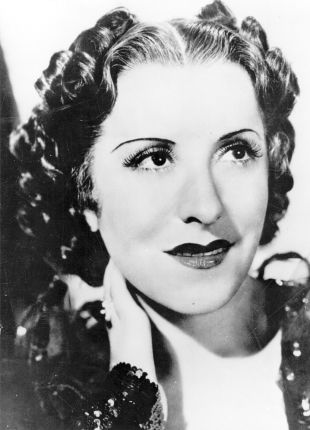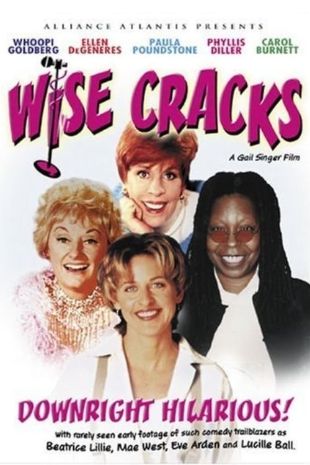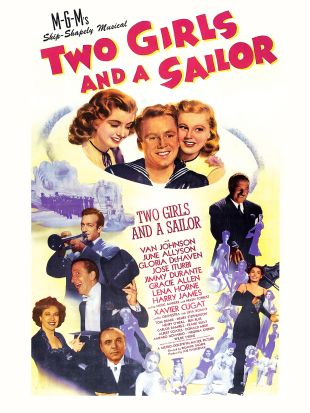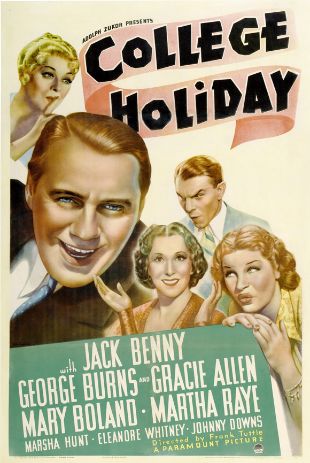The daughter of a musical comedy performer, San Francisco-born comedienne Gracie Allen joined her sisters on the vaudeville stage at the age of 3 1/2. After convent school, Allen returned to the family act, then at age 18 joined the Larry Reilly Stock Company. Quitting the Reilly troupe over a dispute about billing, Allen left show business to become a secretary. In 1922, she was introduced by her showbiz friends to struggling vaudevillian George Burns. After striking out professionally with several male partners, Burns was anxious to launch a boy-girl act. He and Allen toured small-time vaudeville with a routine largely borrowed from other performers. At the time, it was customary in boy-girl routines for the girl to play "straight" while the boy told the jokes, but as Burns would later claim, "They laughed at all of her questions but none of my answers." Burns wisely switched roles, allowing Allen to be the "funny one." Allen's stage character would ever after be the dumb-dora chatterbox who confounded Burns with her convoluted logic. Burns would react in exasperation to double the laugh, but learned early on that he couldn't indulge in any slapstick with Allen; the audience was firmly on her side, and wouldn't stand for any rough stuff. After three years of courtship, Burns finally convinced Allen to marry him in 1926 (it was her first marriage, his second). That same year the team graduated to the prestigious Palace Theatre with an act called "Dizzy"; later on they would score a bigger success with the Al Boasberg-written routine Lambchops. While touring the British Isles in 1929, Burns and Allen made their radio debut with a 26-week BBC series. Back in New York, they began appearing in one-reel movie comedy shorts, first for Vitaphone, then Paramount. Rudy Vallee "discovered" the team for American radio in 1931; the next year, they costarred with Guy Lombardo on a weekly CBS program, quickly entering the realm of folklore with an extended running gag about Allen's "missing brother." With The Big Broadcast (1932), Burns and Allen inaugurated their feature-film career, first as guest stars and supporting players, and finally as leads in such programmers as Many Happy Returns (1934), Love in Bloom (1935) and Here Comes Cookie (1936). Though their film career had begun to peter out by the late 1930s, Burns and Allen were selected to costar with Fred Astaire in his first film without Ginger Rogers, A Damsel in Distress (1937). Here for the first time, the moviegoing public was treated to the terpsichorean skill of Burns and Allen, who not only kept up with Astaire, but at times matched him step for step. In 1939, mystery writer S. S. Van Dyne came up with a "Philo Vance" story idea titled The Gracie Allen Murder Case. While both Burns and Allen "appear" in the published version of the story, Allen alone starred in the 1939 film version, driving erudite detective Vance (Warren William) to distraction by referring to him as Fido Vance. Allen could get a bit trying without Burns around to rein in her insanity, but audiences were pleased with The Gracie Allen Murder Case, prompting MGM to concoct another Gracie Allen solo vehicle, Mr. and Mrs. North (1941). With the exception of a guest appearance in Two Girls and a Sailor (1944), the North film closed out Allen's movie career. She stayed busy in radio, and made headlines in 1940 when Burns concocted a nonsensical presidential campaign for Allen on the Surprise Party ticket. When their radio ratings began dropping in the 1940s, Burns changed their radio characterizations from young sweethearts to middle-aged parents (the couple had adopted two children in the 1930s); this transition was successful, and was carried over into the popular Burns and Allen TV series, which ran from 1950 through 1958. Plagued by illness and increasing stage fright, Allen decided to retire in 1958, a move that warranted a cover story in Life magazine. Burns continued performing without her, working with several partners (including Carol Channing) until he felt secure enough to go it alone. Comfortably retired for many years, Gracie Allen died in her sleep of a heart attack in August of 1964.

Gracie Allen
Share on
Biography by AllMovie
Movie Highlights
Factsheet
- Birth certificate was lost in the San Francisco earthquake of 1906. As a result, her birth year is often cited as anywhere from 1895 to 1905.
- Was in a vaudeville act with her sister Bessie in 1909; and branched out with a solo vaudeville act in 1911.
- Always wore long sleeves to hide the scar from a pot of hot tea that fell on her when she was a child.
- In 1923, while attending secretarial school in Hoboken, N.J., she met George Burns at a vaudeville theater in Union City, N.J.; called Burns "Nattie" (his real name was Nathan Birnbaum), he called her "Googie."
- In his memoir Gracie: A Love Story, George said that "Gracie was the whole act...I didn't have to be a genius to understand that there was something wrong with a comedy act when the straight lines got more laughs than the punch lines."
- Known primarily for radio and TV, Allen and Burns also appeared in several films, including an impressive turn in A Damsel in Distress (1937), Fred Astaire's first RKO musical without Ginger Rogers.
- Star on Hollywood Walk of Fame is located at 6672 Hollywood Blvd. (Burns has three.)
- Married Burns in 1926 (her first marriage; his second). They starred in a weekly radio show from 1932 until 1950; starred in TV's The Burns and Allen Show from 1950 until 1958, when she retired.


